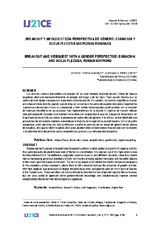Mostrar el registro sencillo del ítem
Escape room y webquest con perspectiva de género: Eumachia y Acilia Plecusa, matronas romanas
| dc.contributor.author | Torres-González, Víctor A. | |
| dc.contributor.author | Pérez Zurita, Antonio D. | |
| dc.date.accessioned | 2023-02-23T12:03:34Z | |
| dc.date.available | 2023-02-23T12:03:34Z | |
| dc.date.issued | 2022 | |
| dc.identifier.issn | 2444-3921 | |
| dc.identifier.uri | http://hdl.handle.net/10396/24770 | |
| dc.description.abstract | Los autores clásicos transmiten una imagen de la mujer romana bastante parcial y llena de tópicos negativos, dedicada fundamentalmente al cuidado del hogar y de los hijos. Toda aquella fémina que se saliera de este rígido esquema era duramente criticada por ello. En cambio, las fuentes epigráficas revelan una situación bien distinta, puesto que en ellas se conserva el recuerdo de mujeres realizando importantes y generosas donaciones hacia su comunidad, o bien siendo homenajeadas públicamente con la erección de estatuas honoríficas en los espacios más representativos de la ciudad. El objetivo de nuestro artículo será precisamente trasladar esa realidad transmitida por la epigrafía al aula de Educación Secundaria, en la que todavía hace falta aumentar la presencia de contenidos de género. A tal efecto, se han diseñado dos propuestas de actividades digitales para trabajar la historia de la mujer en la ciudad romana. Como se podrá comprobar, estos ejercicios no sólo contribuyen a paliar la carencia de los temas de género en los planes de estudios, sino que también resultan útiles para abordar otros conocimientos relacionados con la materia y simultáneamente desarrollar varias competencias gracias a su enfoque interdisciplinar. | es_ES |
| dc.description.abstract | Roman woman’s picture emerged from the ancient authors is rather partial and plenty of negative clichés: they were basically devoted to take care of the homeand children. Any woman out of this rigid scheme was harshly criticised for it. Nevertheless, epigraphic sources reveal a very different situation, since they record women bestowing generous donations to their community or being publicly honoured with honorific statues in the most important places in the town. The aim of our paper is to transfer this reality showed by epigraphy to the secondary school classroom, where there is still a need to increase the presence of gender content. With that purpose, two proposals for digital activities have been designed to work on the history of women in the Roman town.These activities not only contribute to diminish the lack of gender topics in the curriculum, but are also useful to approach other gender-related knowledge and simultaneously improve several competencies thanks to their interdisciplinary approach. | es_ES |
| dc.format.mimetype | application/pdf | es_ES |
| dc.language.iso | spa | es_ES |
| dc.publisher | Universidad de Córdoba, UCOPress | es_ES |
| dc.rights | https://creativecommons.org/licenses/by-nc-nd/4.0/ | es_ES |
| dc.source | International Journal for 21st Century Education 9 (1), 3-19 (2022) | es_ES |
| dc.subject | Antigua Roma | es_ES |
| dc.subject | Historia de la mujer | es_ES |
| dc.subject | Epigrafía latina | es_ES |
| dc.subject | Gamificación | es_ES |
| dc.subject | digital storytelling | es_ES |
| dc.subject | Ancient Rome | es_ES |
| dc.subject | Women’s History | es_ES |
| dc.subject | Latin Epigraphy | es_ES |
| dc.subject | Gamification | es_ES |
| dc.subject | Digital Story | es_ES |
| dc.title | Escape room y webquest con perspectiva de género: Eumachia y Acilia Plecusa, matronas romanas | es_ES |
| dc.title.alternative | Breakout and webquest with a gender perspective: Eumachia and Acilia Plecusa, roman matrons | es_ES |
| dc.type | info:eu-repo/semantics/article | es_ES |
| dc.relation.publisherversion | http://www.uco.es/ucopress/ojs/index.php/ij21ce/index | es_ES |
| dc.rights.accessRights | info:eu-repo/semantics/openAccess | es_ES |

